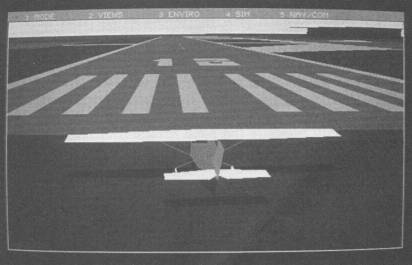A Flight Simulator Odyssey
by Charles Gulick
Roots
Chart: Chicago
Title: LONG FNL CGX 18
En Route Coordinates:
Aircraft: N17215, E16670
Tower: N17188.339, E16670.893
Altitude:
Aircraft: 1500
Tower: See text
Heading: 180
Time: Dawn (06:01)
We can't be in the main program and not pay homage to Merrill C. Meigs airport. It's the "home" airport of the earlier versions of Flight Simulator--perhaps it's the home of the version you're flying now--and where many a simulator pilot took an all-too-popular "crash" course. The CGX in the title is the official airport code for Meigs (we'll use such codes in titles wherever appropriate, since they are standard abbreviations).

Just before touchdown
If (in tower-capable versions) the tower view looks right, leave the altitude alone, whatever it is. If it doesn't--for instance the observer appears to be a mole in its burrow--try ALT 595. The simulator can get very confused at Meigs. When the tower view is right, however, it's a beauty in this scenario.
Altitude is often misconstrued by the simulator, so check it and if necessary reset it to 1500 feet. (On some occasions, in some versions, the simulator will incorrectly interpret all inflight altitudes and ground elevations in the same area. In those cases, the only remedy I know of is to recall a situation that has the aircraft on the ground, and then proceed to recall the desired inflight mode. This is the procedure to use if what you see on the screen, together with a queer altimeter reading, is not what you expected.)
You're on an early morning approach to Runway 18 at Meigs, one of the prettier dawn/dusk approaches in the Chicago area. The buildings you can see are the John Hancock Building and, out the right side, Sears Tower.
Chicago was the first city in the U.S. to have skyscrapers, and the Sears Tower is the world's tallest. When you sit in the Skydeck there, you're at an altitude of 1353 feet--not much below your present inflight altitude. The 94-floor Han-cock building (no midget, either) is unusual in that it comprises both commercial and residential space, with the result that some residents commute to work by elevator (great when it's snowing outside).
Due to the early hour, you can't tell what's water and what's land below you, but Meigs is virtually surrounded by the waters of Lake Michigan and Burnham Park Harbor. Only a thin peninsula just this side of the runway keeps it from being an island. On the tip of the peninsula is the Adler Planetarium, directly opposite the Field Museum of Natural History in Chicago proper. The colorful lakefront marinas and Grant Park are strung along Chicago Harbor, this side of Meigs.
Start letting down for your landing when the Hancock building is off your right wingtip. You're seeing the outline of the entire airport complex at this distance, and the lie of the runway is not readily apparent, so don't be in a hurry to yaw left or right.
When the runway itself takes shape, do what you feel you should if you need to improve your alignment. And keep on doing that, right down to the threshold. Use power changes to improve your final approach. If you feel you're high, reduce power, or put on some flaps to permit a steeper descent; if low, increase power or apply some up elevator to stretch the final approach. Try to keep the runway threshold at or slightly below the center of your windshield, all the way down.
Elevation at Meigs is just under 600 feet.
For a whole different perspective, you can advance the time one hour and fly the preceding situation in daylight.
Table of Contents | Previous Section | Next Section
